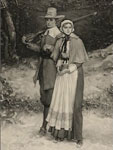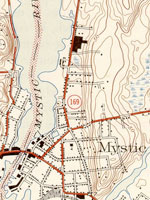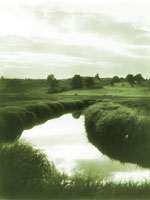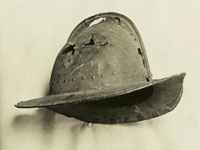Joseph Smith: Rough Stone Rolling
Professor Richard L. Bushman reviews the life and character of Joseph Smith, Mormon prophet and founder, and explores Smith's New England roots.
Audio and video options are available.
Professor Richard L. Bushman reviews the life and character of Joseph Smith, Mormon prophet and founder, and explores Smith's New England roots.
Audio and video options are available.
John Quincy, Jr., 11th-generation descendent of the New England Quincy family, traces the history of the family, a dominant force in area politics (the Boston mayorage passed from Quincy father to son for several generations).

Would you agree that Puritan New England was the "cradle" of America?
Puritan New England has long been given priority as a model for the development of America as a whole. There are a number of possible reasons for this regional prejudice. For one thing, historians have simply found it easier to research colonial New England because of the abundance of written sources that were created and have survived there. Additionally, the image of Pilgrims and Indians sitting down together at the first Thanksgiving meal makes a more comforting foundational moment than the messy first years at Jamestown, marked as they seem to have been by sloth, greed, and starvation.
The Puritans’ perception of their having been chosen for divine purposes, it has been suggested, also meshes well with America’s sense of manifest destiny, which was not just a geographical expansion, but also a moral one. And of course, the shadow of the Civil War casts itself over the whole question, making it tempting to write the South and its defense of slavery out of the mainstream of national development. This view assumes that the South was always hostile to economic innovation and forgets that slavery also existed in colonial New England.
Therefore, the idea that New England was the cradle of America is composed of different interlocking arguments. Prying them apart, we can ask the following questions:
One historian, Jack Greene, in his book Pursuits of Happiness, makes an argument against the exclusive use of New England as a model of development for later American history. Greene argues that it was precisely to get away from the conditions marking contemporary England that Puritans emigrated in the first place. Their gathered churches, egalitarian society (compared to England), and their rejection of the market economy were all in contrast to developments in England. (1)
As research is now showing, English society at this time was much more mobile than previously thought, and was not composed of stable, static rural communities. (2) Agriculture in England was increasingly a commercial venture, dominated by large landowners who depended on tenants and wage laborers. For those who controlled their own smallholdings, the nuclear family composed of parents and children was not the unit of production, as it was in New England; rather, children were typically apprenticed out, and households employed other laborers. Laborers and apprentices were often involved in nonagricultural pursuits, notably the cloth industry. (3) English society, then, was open, competitive, stratified, and acquisitive, all of which makes New England seem much less English than its name might imply.
Looking at the question from the perspective of the colonial Chesapeake (specifically Jamestown), settlers both brought with them from England and maintained in the New World attitudes and values regarding family, community, work, order, and religion. (4) In addition, by the 1630s the Chesapeake was not the chaotic and divided society often depicted. Political stability had been achieved and community networks had been created despite dispersed settlement patterns. (5) Other historians have noted that despite the lack of personal religious inclinations on the part of individual settlers in Virginia, the colony was founded with religious goals at the forefront, and that the ethos behind these was essentially Puritan. (6)
All of this takes away from New England’s place of primacy as either most English or most unlike other colonies. At the same time, it has been argued that New England did lack traits that other colonies—as well as the later United States—exhibited. It was, for example, much less ethnically diverse than colonies founded later in the 17th century. The Middle Colonies with their Dutch, German, Scotch-Irish, Welsh, Swedish, and Jewish settlers, and even Carolina with Huguenots, Highland Scots, Jews, and a large population of enslaved African Americans offer a better foretaste of the future multiethnic America.
The varying trajectories of the colonies all offered patterns for later American development, and the issue of originary myths did not begin with modern historians, nor even with the Civil War. In the quest for a national identity following the Revolution, each region articulated its own vision and insisted on its own importance to the development of the American character. New Englanders saw their regional characteristics of piety, industry, simplicity, and democracy as essentially American, but felt they were not shared by Southerners due to the widespread institution of slavery. This self-image came to be adopted by other Northern states, and because of migration by New Englanders to Western territories, it was spread there as well. (7) The South was in effect outflanked in its claims to be the repository of American ideals. It is for modern historians to look beyond these regional prejudices and adopt a more nuanced and inclusive view of the formative influences of the American past.
1 Greene, Jack P. Pursuits of Happiness: The Social Development of Early Modern British Colonies and the Formation of American Culture. Chapel Hill, NC: University of North Carolina Press, 1988.
Bushman, Richard. From Puritan to Yankee: Character and the Social Order in Connecticut, 16901765. Harvard University Press, 1967.
2 Whyte, Ian. Migration and Society in Britain: 15501830. New York: St. Martin’s Press, 2000.
3 Wrightson, Keith. English Society, 15801680. New Brunswick, N.J: Rutgers University Press, 1982.
4 Horn, James. Adapting to a New World: English Society in the 17th-Century Chesapeake. Chapel Hill, NC: The University of North Carolina Press, 1994.
5 Kukla, Jon. “Order and Chaos in Early America: Political and Social Stability in Pre-Restoration Virginia.” The American Historical Review, 90:2 (April 1985).
Carr, Lois Green. “Sources of Political Stability and Upheaval in 17th-Century Maryland.” In Planters and Yeomen: Selected Articles on the Southern Colonies, edited by Peter Charles Hoffer (New York: Garland Publishing, 1988).
6 Miller, Perry. "The Religious Impulse in the Founding of Virginia: Religion and Society in the Early Literature.” The William and Mary Quarterly, 5:4 (October 1948).
7 Kermes, Stephanie. Creating an American Identity: New England, 1789-1825. New York: Palgrave Macmillan, 2008.

A collection of more than 1,100 topographical maps created by the United States Geological Survey from the 1890s to the 1950s covering all of New England—Maine, New Hampshire, Vermont, Rhode Island, Massachusetts, and Connecticut—and selected areas of New York. The maps—which reveal roads, buildings, rail lines, bodies of water, and elevations—occur in 15-minute and 7.5-minute quadrangle series (a minute is one-sixtieth of a degree of latitude or longitude). In addition, the collection includes six maps with 30-minute quadrangles.
For states other than New York, users can view a state image map and select a point within a grid marked off in 15-minute increments to find listings for available images accompanied by dates the maps were surveyed, created, and revised. Towns within each quadrangle are also listed along with names of adjacent areas. Users also may search an alphabetical list of towns within each state. For New York, only an index of quadrangles names is available. Maps are presented in JPEG format. According to the site, "Each image is typically 2 megabytes, so download times are likely to be slow." A useful site for those studying changes in the New England landscape during the first half of the 20th century.

How would I find more information on Martha Ballard’s religion and other personal information to help me write a better primary source analysis?
To learn about 18th-century Maine midwife Martha Ballard, first, read Laurel Thatcher Ulrich’s A Midwife’s Tale: The Life of Martha Ballard, Based on Her Diary, 1785-1812 (New York: Vintage, 1991). You could also watch the 1998 PBS video A Midwife’s Tale which comes with a teacher’s guide.
Second, look at the resources collected for the “case study” on Martha Ballard on the Do History website. The website has an archive of some primary sources, including extensive selections from her diary, giving some background and context for Ballard’s religion.
Third, a “Martha Ballard Study Pack,” a study guide for students of A Midwife’s Tale, and a lesson plan for teachers is available from BookRags.
A good website for teachers on the history of Maine with plenty of primary resources is the Maine Historical Society’s Maine Memory Network. Included on that site is Religion on Maine’s Frontier, an online essay with selected images.
If you wish to begin digging into the history of the everyday life of the people of Maine, you should also take a look at the available sources on Maine history and genealogy at Cyndi’s List.
Valentine Seaman, M.D. The Midwives Monitor, and Mothers Mirror: being three concluding lectures of a course of instruction on Midwifery. New York: Isaac Collins, 1800.
Oxford, Maine, historical information
This iCue Mini-Documentary describes the war that ignited between England and France when a young George Washington was drawn into a skirmish with French scouts. Control over the continent of America was at stake as the two world powers conducted a massive war in the colonies.

Directing my first Teaching American History (TAH) grant in 2003, I had three years to spend nearly a million dollars providing professional development to teachers of American history. What could go wrong?
Plenty, of course. Organizational issues aside, the project faced two challenges. First, given the dollars and the time we had to spend, we simply could not get enough teachers to fill the seats. I have heard over the years TAH grant directors complain about recruitment. "We offer these fabulous programs," they sigh, "but people don’t come."
Program quality could never overcome the structural issue: the teachers in our service area could not consume all the professional development we offer. We had a serious problem of oversupply.
None of the obvious solutions made much sense. We couldn't provide less professional development than the grant proposal promised, or serve fewer teachers. We had to expand our pool of teachers, and expand it quickly.
In New England, with its many districts in a small geographical area, the solution was simple if politically tenuous: invite other districts into a consortium to expand the market for our offerings. We maintained our relationship with our primary partner by providing them with preferred service: guaranteed spots, special privileges, and direct curricular support. Our pool of available teachers tripled, and we seldom had any recruitment issues.
Districts more geographically distributed could achieve the same result through distance learning options. Most higher education partners have that capability already; why not use it?
The second problem had to do with the offerings themselves. The proposal I had been brought in to manage promised a smorgasbord of professional development: institutes, lectures, seminars, and graduate-level courses. We could mix and match as the talents and availability of our historians dictated.
The menu of potential professional development is limited. We asked teachers what they wanted and districts what they would support, and rounded up the usual suspects. But the offerings sometimes sputtered. We filled the seats, and people liked what we gave them, but the self-reported impact on students never satisfied us.
We hit on two solutions, one that any existing grant holder can replicate, and another that has to grow organically out of a proposal from the start.
The organic solution proposes a three-year project that intends to create a specific change in a region. Instead of planning to offer the usual types of professional development organized around a unifying theme, look at what your districts need to organically change the way they teach history.
The first TAH grant I wrote sponsored school-based teams of elementary teachers working together for a year to add flesh to the statewide standards. By the time we finished, a third of the region's elementary schools had gone through the process, and another third had heard detailed reports about the changes.
The second grant supported a research-based induction program for new teachers of American history. Few districts could afford a state-of-the-art induction program, but the TAH grant, coming just as history faculty turned over through retirement, filled that need.
These proposals (and more I have written and received) started from the question, "What do the teachers and districts need to improve history instruction?" rather than "What professional development can we provide teachers and districts?" Districts gladly bought in to these organically conceived proposals. We could explain the grant in a sentence, a sentence that spoke to pressing educational needs.
The other program came almost as an afterthought, when the first grant had an unspent balance. We brought together a group of teachers who had worked with us for years. We asked them to assemble booklets of primary sources that they thought could amplify the richness and meaning of some key documents in American history.
We ended up publishing five booklets—on the Declaration, the Constitution, the Bill of Rights, the Gettysburg Address and "I Have a Dream"—each containing 60 or more primary sources. We distributed them for free to every history teacher in the region. The booklets attracted more money and support, and have been distributed across the state.
The teachers who created the booklets described the work as the best professional development they ever experienced, transformative personally and professionally. And the booklets are used, bringing students closer to primary sources, some obvious and some arcane, than ever before.
TAH grants can provide immense service to students and their teachers. A little creativity makes a world of difference in their success.
Built around 1687 for the young family of William Boardman, a local joiner, this house has survived remarkably intact since its construction.
The house offers tours.
The Cooper-Molera Adobe was fully restored in the 1980s and now shows visitors the full elegance and wealth of the John Rogers Cooper family. In addition to the home, the adobe also has two full acres which are open to visitors. Visitors can see the barns, vegetable and fruit gardens, and farm animals that the Cooper family owned.
The home offers guided tours. The website offers basic historical and visitor information.

I am teaching The Scarlet Letter in my AP Literature class and need some higher-level resources that discuss the Puritan lifestyle, from dress to their interactions with natives to their belief systems. Do you know of several resources?
On the material culture of Plymouth Colony, including descriptions of housing, furniture, clothing, and family life and relationships, you could look at John Demos, A Little Commonwealth: Family Life in Plymouth Colony, or his, Remarkable Providences: Readings on Early American History. Also good is David Hackett Fischer, Albion’s Seed: Four British Folkways in America, section on “The Exodus of the English Puritans, 1629-41.”
Easily the most influential book about the New England Puritans' religion has been Perry Miller's 1956, Errand into the Wilderness. More recent and well-regarded books include Sacvan Bercovitch, The Puritan Origins of the American Self and David D. Hall, Worlds of Wonder, Days of Judgment: Popular Religious Belief in Early New England.
Online, Professor Donna M. Campbell’s valuable web pages on “Puritanism in New England” may help begin to clarify some of the Puritans’ religious beliefs.
Also online, you can find plenty to read and assign in volumes 1 and 2 of A Library of American Literature, edited by Edmund Stedman and Ellen Hutchinson, and compiled and published in 1887, and which is available via Google Books. The editors included diverse short selections from Puritan writers describing their inner and outer lives and their adventures in settling in America.
A newer anthology of Puritan writings, focusing exclusively on religion (and not available on the web), is The Puritans in America: A Narrative Anthology, edited by Alan Heimert and Andrew Delbanco, published in 1985 by Harvard University Press.
Teaching The Scarlet Letter and also reading historical works from and about the Puritans provides an opportunity to emphasize to students that Hawthorne's work was one of historical fiction, written almost two centuries after the events it imagined. Students can easily understand that the book is fiction because the specific people and events its described did not actually exist. They may need some help, however, in understanding that Hawthorne's Puritan world might differ from the real Puritans' world, or in understanding that Hawthorne's fictional enterprise was deeply imbued with mid-19th-century sensibilities and preoccupations. A 17th-century Puritan would never have written a book like it.
Sacvan Bercovitch, The Puritan Origins of the American Self. New Haven: Yale University Press, 1978.
David D. Hall, Worlds of Wonder, Days of Judgment: Popular Religious Belief in Early New England. Cambridge: Harvard University Press, 1990.
Alan Heimert and Andrew Delbanco, eds. The Puritans in America: A Narrative Anthology. Cambridge: Harvard University Press, 1985.
John Demos, A Little Commonwealth: Family Life in Plymouth Colony. 2nd edition. New York: Oxford University Press, 2000.
John Demos, Remarkable Providences: Readings on Early American History, rev. edition. Boston: Northeastern University Press, 1991.
David Hackett Fischer, Albion’s Seed: Four British Folkways in America. New York: Oxford University Press, 1989.
Perry Miller, Errand into the Wilderness. Cambridge: Harvard University Press, 1956